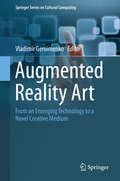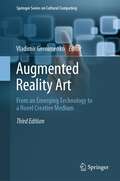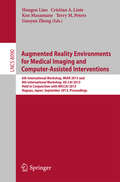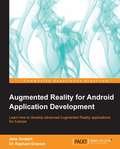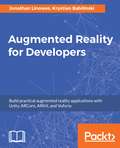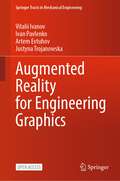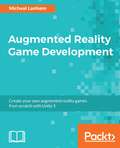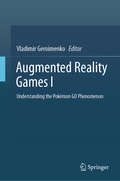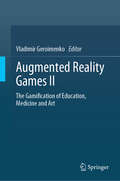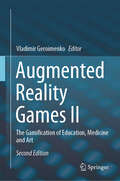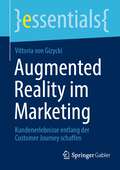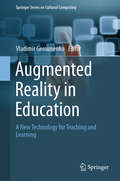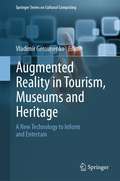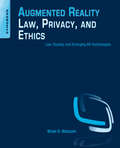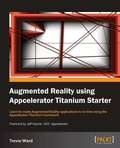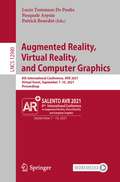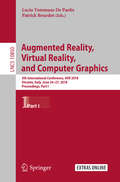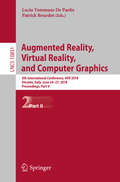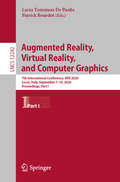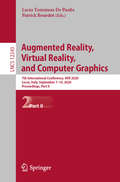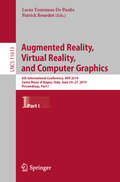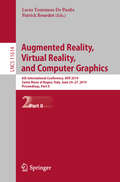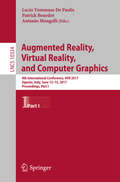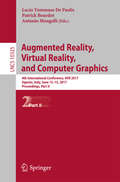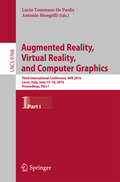- Table View
- List View
Augmented Reality Art: From an Emerging Technology to a Novel Creative Medium (Springer Series on Cultural Computing)
by Vladimir GeroimenkoWritten by a team of world-renowned artists, researchers and practitioners - all pioneers in using augmented reality based creative works and installations as a new form of art - this is the first book to explore the exciting new field of augmented reality art and its enabling technologies. As well as investigating augmented reality as a novel artistic medium the book covers cultural, social, spatial and cognitive facets of augmented reality art. Intended as a starting point for exploring this new fascinating area of research and creative practice it will be essential reading not only for artists, researchers and technology developers, but also for students (graduates and undergraduates) and all those interested in emerging augmented reality technology and its current and future applications in art.
Augmented Reality Art: From an Emerging Technology to a Novel Creative Medium (Springer Series on Cultural Computing)
by Vladimir GeroimenkoThis is the third edition of the first ever book to explore the exciting field of augmented reality art and its enabling technologies. The new edition has been thoroughly revised and updated, with 9 new chapters included. As well as investigating augmented reality as a novel artistic medium, the book covers cultural, social, spatial and cognitive facets of augmented reality art. It has been written by a virtual team of 33 researchers and artists from 11 countries who are pioneering in the new form of art, and contains numerous colour illustrations showing both classic and recent augmented reality artworks.Intended as a starting point for exploring this new fascinating area of research and creative practice, it will be essential reading not only for artists, researchers and technology developers, but also for students (graduates and undergraduates) and all those interested in emerging augmented reality technology and its current and future applications in art.
Augmented Reality Environments for Medical Imaging and Computer-Assisted Interventions: International Workshops (Lecture Notes in Computer Science #8090)
by Hongen Liao Cristian A. Linte Ken Masamune Terry M. Peters Guayan ZhengThis book constitutes the refereed proceedings of two workshops MAIR/AE-CAI 2013, held in conjunction with MICCAI 2013, held in Nagoya, Japan, in September 2013. The 29 revised full papers presented were carefully reviewed and selected from 44 submissions. The papers cover a wide range of topics addressing the main research efforts in the fields of medical image formation, analysis and interpretation, augmented reality and visualization, computer assisted intervention, interventional imaging, image-guided robotics, image-guided intervention, surgical planning and simulation, systematic extra- and intra-corporeal imaging modalities, and general biological and neuroscience image computing.
Augmented Reality for Android Application Development
by Jens Grubert Dr Raphael GrassetA step-by-step tutorial-based guide aimed at giving you hands-on practical experience to develop AR applications for Android.Augmented Reality for Android Application Development is for Android mobile application developers who are familiar with Android Development Tools and deployment, JMonkeyEngine, and the Vuforia SDK.
Augmented Reality for Developers: Build practical augmented reality applications with Unity, ARCore, ARKit, and Vuforia
by Jonathan Linowes Krystian BabilinskiBuild exciting AR applications on mobile and wearable devices with Unity 3D, Vuforia, ARToolKit, Microsoft Mixed Reality HoloLens, Apple ARKit, and Google ARCore About This Book • Create unique AR applications from scratch, from beginning to end, with step-by-step tutorials • Use Unity 3D to efficiently create AR apps for Android, iOS, and Windows platforms • Use Vuforia, ARTookKit, Windows Mixed Reality, and Apple ARKit to build AR projects for a variety of markets • Learn best practices in AR user experience, software design patterns, and 3D graphics Who This Book Is For The ideal target audience for this book is developers who have some experience in mobile development, either Android or iOS. Some broad web development experience would also be beneficial. What You Will Learn • Build Augmented Reality applications through a step-by-step, tutorial-style project approach • Use the Unity 3D game engine with the Vuforia AR platform, open source ARToolKit, Microsoft's Mixed Reality Toolkit, Apple ARKit, and Google ARCore, via the C# programming language • Implement practical demo applications of AR including education, games, business marketing, and industrial training • Employ a variety of AR recognition modes, including target images, markers, objects, and spatial mapping • Target a variety of AR devices including phones, tablets, and wearable smartglasses, for Android, iOS, and Windows HoloLens • Develop expertise with Unity 3D graphics, UIs, physics, and event systems • Explore and utilize AR best practices and software design patterns In Detail Augmented Reality brings with it a set of challenges that are unseen and unheard of for traditional web and mobile developers. This book is your gateway to Augmented Reality development—not a theoretical showpiece for your bookshelf, but a handbook you will keep by your desk while coding and architecting your first AR app and for years to come. The book opens with an introduction to Augmented Reality, including markets, technologies, and development tools. You will begin by setting up your development machine for Android, iOS, and Windows development, learning the basics of using Unity and the Vuforia AR platform as well as the open source ARToolKit and Microsoft Mixed Reality Toolkit. You will also receive an introduction to Apple's ARKit and Google's ARCore! You will then focus on building AR applications, exploring a variety of recognition targeting methods. You will go through multiple complete projects illustrating key market sectors including business marketing, education, industrial training, and gaming. By the end of the book, you will have gained the necessary knowledge to make quality content appropriate for a range of AR devices, platforms, and intended uses. Style and approach This book adopts a practical, step-by-step, tutorial-style approach. The design principles and methodology will be explained by creating different modules of the AR app.
Augmented Reality for Engineering Graphics (Springer Tracts in Mechanical Engineering)
by Vitalii Ivanov Ivan Pavlenko Artem Evtuhov Justyna TrojanowskaThis open access book offers a timely snapshot of Augmented Reality (AR) technology, with an emphasis on its application within the mechanical and manufacturing engineering domains, for both educational and industrial purposes. Reporting on the experience of the authors, the book introduces readers to the principles of product design, with an emphasis on modern strategies and approaches for user-centered design, creativity, and design for manufacturing and sustainability. It guides to the application augmented reality and visualization techniques in the design process. In turn, it describes an AR mobile application developed by the authors to transform 2D drawings into dynamic 3D objects. The book also includes exercises. All in all, this book offers a practice-oriented guide to Augmented Reality applications in mechanical engineering and education, addressing advanced undergraduate students, lecturers, and professionals in the engineering field. This is an open access book.
Augmented Reality Game Development
by Micheal Lanham 1 20 2017Create your own augmented reality games from scratch with Unity 5About This BookCreate your own augmented reality game from scratch and join the virtual reality gaming revolutionUse the latest Unity 5 VR SDK to create pro-level AR games like Pokemon GoInnovate and explore the latest and most promising trend of AR gaming in the mobile gaming industryWho This Book Is ForThis book is for those who have a basic knowledge of game development techniques, but no previous knowledge of Unity is required. Some basic programming knowledge would be desirable, but the book is an introduction to the topic. The book is also suitable for experienced developers new to GIS or GPS development.What You Will LearnBuild a location-based augmented reality game called Foodie GoAnimate a player's avatar on a mapUse the mobile device's camera as a game backgroundImplement database persistence with SQLLite4Unity3D to carry inventory items across game sessionsCreate basic UI elements for the game, inventory, menu, and settingsPerform location and content searches against the Google Places APIEnhance the game's mood by adding visual shader effectsExtend the game by adding multiplayer networking and other enhancementsIn DetailThe heyday of location-based augmented reality games is upon us. They have been around for a few years, but the release of Pokemon Go was a gamechanger that catalyzed the market and led to a massive surge in demand. Now is the time for novice and experienced developers alike to turn their good ideas into augmented reality (AR) mobile games and meet this demand!If you are keen to develop virtual reality games with the latest Unity 5 toolkit, then this is the book for you. The genre of location-based AR games introduces a new platform and technical challenges, but this book will help simplify those challenges and show how to maximize your game audience.This book will take you on a journey through building a location-based AR game that addresses the core technical concepts: GIS fundamentals, mobile device GPS, mapping, map textures in Unity, mobile device camera, camera textures in Unity, accessing location-based services, and other useful Unity tips. The technical material also discusses what is necessary for further development to create a multiplayer version of the game. At the end, you will be presented with troubleshooting techniques in case you get into trouble and need a little help.Style and approachThis book shows you how to create every step of the game and gives practical examples.
Augmented Reality Games I: Understanding the Pokémon GO Phenomenon
by Vladimir GeroimenkoThis is the first of two comprehensive volumes that provide a thorough and multi-faceted research into the emerging field of augmented reality games and consider a wide range of its major issues. These first ever research monographs on augmented reality games have been written by a team of 70 leading researchers, practitioners and artists from 20 countries. In Volume I, the phenomenon of the Pokémon GO game is analysed in theoretical, cultural and conceptual contexts, with emphasis on its nature and the educational use of the game in children and adolescents. Game transfer phenomena, motives for playing Pokémon GO, players’ experiences and memorable moments, social interaction, long-term engagement, health implications and many other issues raised by the Pokémon GO game are systematically examined and discussed. Augmented Reality Games I is essential reading not only for researchers, practitioners, game developers and artists, but also for students (graduates and undergraduates) and all those interested in the rapidly developing area of augmented reality games.
Augmented Reality Games II: The Gamification of Education, Medicine and Art
by Vladimir GeroimenkoThis is the second of two comprehensive volumes that provide a thorough and multi-faceted research into the emerging field of augmented reality games and consider a wide range of its major issues. These first ever research monographs on augmented reality games have been written by a team of 70 leading researchers, practitioners and artists from 20 countries. Volume II explores the most important and challenging issues that have been raised by the use of the Augmented Reality approach and technology in the gamification of education, healthcare, medicine and art. The volume deals with a systematic analysis of educational augmented reality games, their use for health promotion in old age and for improving people’s well-being, the gamification of augmented reality art and immersive reading experiences, among other topics. Augmented Reality Games II is essential reading not only for researchers, practitioners, game developers and artists, but also for students (graduates and undergraduates) and all those interested in the rapidly developing area of augmented reality games.
Augmented Reality Games II: The Gamification of Education, Medicine and Art
by Vladimir GeroimenkoThis is the second edition of the first ever research monograph that explores the exciting field of augmented reality games and their enabling technologies. The new edition has been thoroughly revised and updated, with 6 new chapters included. As well as investigating augmented reality games in education, the book covers the gamification of medicine, healthcare, and art. It has been written by a team of 43 researchers, practitioners, and artists from 12 countries, pioneering in developing and researching the new type of computer games.This book deals with a systematic analysis of educational augmented reality games, the gamification of elementary and secondary education, teachers’ novel key skills and new teaching methods in the classroom, creating immersive and playful reading experiences, augmented reality games for health promotion in old age and for transforming dental and physical education and practice, the gamification of augmented reality art, pervasive games, and gaming in public spaces, among other topics.Intended as a starting point for exploring this new fascinating area of research and game development, it will be essential reading not only for researchers, practitioners, game developers, and artists, but also for students (graduates and undergraduates) and all those interested in the rapidly developing area of augmented reality games.
Augmented Reality im Marketing: Kundenerlebnisse entlang der Customer Journey schaffen (essentials)
by Vittoria von GizyckiDie Einsatzmöglichkeiten von Augmented Reality – der Erweiterung der Realität durch digitale Elemente – im E-Commerce sind vielfältig,. Der Verlauf der Customer Journey bietet eine sinnvolle Struktur, um eine systematische Einordnung verschiedener Augmented-Reality-Anwendungen aufzuzeigen. So wird anhand von zahlreichen Beispielen deutlich, dass die Möglichkeiten dieser Technologie noch bei Weitem nicht ausgeschöpft sind und für zahlreiche Unternehmen großes Potenzial bergen.
Augmented Reality in Education: A New Technology for Teaching and Learning (Springer Series on Cultural Computing)
by Vladimir GeroimenkoThis is the first comprehensive research monograph devoted to the use of augmented reality in education. It is written by a team of 58 world-leading researchers, practitioners and artists from 15 countries, pioneering in employing augmented reality as a new teaching and learning technology and tool. The authors explore the state of the art in educational augmented reality and its usage in a large variety of particular areas, such as medical education and training, English language education, chemistry learning, environmental and special education, dental training, mining engineering teaching, historical and fine art education. Augmented Reality in Education: A New Technology for Teaching and Learning is essential reading not only for educators of all types and levels, educational researchers and technology developers, but also for students (both graduates and undergraduates) and anyone who is interested in the educational use of emerging augmented reality technology.
Augmented Reality in Tourism, Museums and Heritage: A New Technology to Inform and Entertain (Springer Series on Cultural Computing)
by Vladimir GeroimenkoThis book provides extensive research into the use of augmented reality in the three interconnected and overlapping fields of the tourism industry, museum exhibitions, and cultural heritage. It is written by a virtual team of 50 leading researchers and practitioners from 16 countries around the world. The authors explore the opportunities and challenges of augmented reality applications, their current status and future trends, informal learning and heritage preservation, mixed reality environments and immersive installations, cultural heritage education and tourism promotion, visitors with special needs, and emerging post-COVID-19 museums and heritage sites. Augmented Reality in Tourism, Museums and Heritage: A New Technology to Inform and Entertain is essential reading not only for researchers, application developers, educators, museum curators, tourism and cultural heritage promoters, but also for students (both graduates and undergraduates) and anyone who is interested in the efficient and practical use of augmented reality technology.
Augmented Reality Law, Privacy, and Ethics: Law, Society, and Emerging AR Technologies
by Brian WassomAugmented Reality (AR) is the blending of digital information in a real-world environment. A common example can be seen during any televised football game, in which information about the game is digitally overlaid on the field as the players move and position themselves. Another application is Google Glass, which enables users to see AR graphics and information about their location and surroundings on the lenses of their "digital eyewear", changing in real-time as they move about. Augmented Reality Law, Privacy, and Ethics is the first book to examine the social, legal, and ethical issues surrounding AR technology. Digital eyewear products have very recently thrust this rapidly-expanding field into the mainstream, but the technology is so much more than those devices. Industry analysts have dubbed AR the "eighth mass medium" of communications. Science fiction movies have shown us the promise of this technology for decades, and now our capabilities are finally catching up to that vision. Augmented Reality will influence society as fundamentally as the Internet itself has done, and such a powerful medium cannot help but radically affect the laws and norms that govern society. No author is as uniquely qualified to provide a big-picture forecast and guidebook for these developments as Brian Wassom. A practicing attorney, he has been writing on AR law since 2007 and has established himself as the world's foremost thought leader on the intersection of law, ethics, privacy, and AR. Augmented Reality professionals around the world follow his Augmented Legality® blog. This book collects and expands upon the best ideas expressed in that blog, and sets them in the context of a big-picture forecast of how AR is shaping all aspects of society.Augmented reality thought-leader Brian Wassom provides you with insight into how AR is changing our world socially, ethically, and legally.Includes current examples, case studies, and legal cases from the frontiers of AR technology.Learn how AR is changing our world in the areas of civil rights, privacy, litigation, courtroom procedure, addition, pornography, criminal activity, patent, copyright, and free speech.An invaluable reference guide to the impacts of this cutting-edge technology for anyone who is developing apps for it, using it, or affected by it in daily life.
Augmented Reality using Appcelerator Titanium Starter
by Trevor WardIt's a quick start tutorial to help you get started with creating Augmented Reality applications and acquainting yourself with essential aspects of creating AR applications using the Appcelerator Titanium Framework. The instructions are clear with easy to follow examples. This book is for anybody who wishes to understand how to build an Augmented Reality Application. It uses the Appcelerator Titanium mobile development framework, but the techniques and practices can be applied to other frameworks and native code. You will need to have a good working knowledge of development and JavaScript, it is not aimed at the beginner.
Augmented Reality, Virtual Reality, and Computer Graphics: 8th International Conference, AVR 2021, Virtual Event, September 7–10, 2021, Proceedings (Lecture Notes in Computer Science #12980)
by Lucio Tommaso De Paolis Pasquale Arpaia Patrick BourdotThis book constitutes the refereed proceedings of the 8th International Conference on Augmented Reality, Virtual Reality, and Computer Graphics, AVR 2021, held in Italy, in September 2021. Due to COVID-19 pandemic the conference was held virtually. The 38 full and 14 short papers were carefully reviewed and selected from 69 submissions. The papers discuss key issues, approaches, ideas, open problems, innovative applications and trends in virtual reality, augmented reality, mixed reality, applications in cultural heritage, in medicine, in education, and in industry.
Augmented Reality, Virtual Reality, and Computer Graphics: 5th International Conference, AVR 2018, Otranto, Italy, June 24–27, 2018, Proceedings, Part I (Lecture Notes in Computer Science #10850)
by Lucio Tommaso De Paolis Patrick BourdotThe 2-volume set LNCS 10850 and 10851 constitutes the refereed proceedings of the 5th International Conference on Augmented Reality, Virtual Reality, and Computer Graphics, AVR 2018, held in Otranto, Italy, in June 2018. The 67 full papers and 26 short papers presented were carefully reviewed and selected from numerous submissions. The papers are organized in the following topical sections: virtual reality; augmented and mixed reality; computer graphics; human-computer interaction; applications of VR/AR in medicine; and applications of VR/AR in cultural heritage; and applications of VR/AR in industry.
Augmented Reality, Virtual Reality, and Computer Graphics: 5th International Conference, AVR 2018, Otranto, Italy, June 24–27, 2018, Proceedings, Part II (Lecture Notes in Computer Science #10851)
by Lucio Tommaso De Paolis Patrick BourdotThe 2-volume set LNCS 10850 and 10851 constitutes the refereed proceedings of the 5th International Conference on Augmented Reality, Virtual Reality, and Computer Graphics, AVR 2018, held in Otranto, Italy, in June 2018. The 67 full papers and 26 short papers presented were carefully reviewed and selected from numerous submissions. The papers are organized in the following topical sections: virtual reality; augmented and mixed reality; computer graphics; human-computer interaction; applications of VR/AR in medicine; and applications of VR/AR in cultural heritage; and applications of VR/AR in industry.
Augmented Reality, Virtual Reality, and Computer Graphics: 7th International Conference, AVR 2020, Lecce, Italy, September 7–10, 2020, Proceedings, Part I (Lecture Notes in Computer Science #12242)
by Lucio Tommaso De Paolis Patrick BourdotThe 2-volume set LNCS 12242 and 12243 constitutes the refereed proceedings of the 7th International Conference on Augmented Reality, Virtual Reality, and Computer Graphics, AVR 2020, held in Lecce, Italy, in September 2020.* The 45 full papers and 14 short papers presented were carefully reviewed and selected from 99 submissions. The papers discuss key issues, approaches, ideas, open problems, innovative applications and trends in virtual reality, augmented reality, mixed reality, 3D reconstruction visualization, and applications in the areas of cultural heritage, medicine, education, and industry. * The conference was held virtually due to the COVID-19 pandemic.
Augmented Reality, Virtual Reality, and Computer Graphics: 7th International Conference, AVR 2020, Lecce, Italy, September 7–10, 2020, Proceedings, Part II (Lecture Notes in Computer Science #12243)
by Lucio Tommaso De Paolis Patrick BourdotThe 2-volume set LNCS 12242 and 12243 constitutes the refereed proceedings of the 7th International Conference on Augmented Reality, Virtual Reality, and Computer Graphics, AVR 2020, held in Lecce, Italy, in September 2020.*The 45 full papers and 14 short papers presented were carefully reviewed and selected from 99 submissions. The papers discuss key issues, approaches, ideas, open problems, innovative applications and trends in virtual reality, augmented reality, mixed reality, 3D reconstruction visualization, and applications in the areas of cultural heritage, medicine, education, and industry. * The conference was held virtually due to the COVID-19 pandemic.
Augmented Reality, Virtual Reality, and Computer Graphics: 6th International Conference, AVR 2019, Santa Maria al Bagno, Italy, June 24–27, 2019, Proceedings, Part I (Lecture Notes in Computer Science #11613)
by Lucio Tommaso De Paolis Patrick BourdotThe 2-volume set LNCS 11613 and 11614 constitutes the refereed proceedings of the 6th International Conference on Augmented Reality, Virtual Reality, and Computer Graphics, AVR 2019, held in Santa Maria al Bagno, Italy, in June 2019.The 32 full papers and 35 short papers presented were carefully reviewed and selected from numerous submissions. The papers discuss key issues, approaches, ideas, open problems, innovative applications and trends in virtual and augmented reality, 3D visualization and computer graphics in the areas of medicine, cultural heritage, arts, education, entertainment, military and industrial applications. They are organized in the following topical sections: virtual reality; medicine; augmented reality; cultural heritage; education; and industry.
Augmented Reality, Virtual Reality, and Computer Graphics: 6th International Conference, AVR 2019, Santa Maria al Bagno, Italy, June 24–27, 2019, Proceedings, Part II (Lecture Notes in Computer Science #11614)
by Lucio Tommaso De Paolis Patrick BourdotThe 2-volume set LNCS 11613 and 11614 constitutes the refereed proceedings of the 6th International Conference on Augmented Reality, Virtual Reality, and Computer Graphics, AVR 2019, held in Santa Maria al Bagno, Italy, in June 2019.The 32 full papers and 35 short papers presented were carefully reviewed and selected from numerous submissions. The papers discuss key issues, approaches, ideas, open problems, innovative applications and trends in virtual and augmented reality, 3D visualization and computer graphics in the areas of medicine, cultural heritage, arts, education, entertainment, military and industrial applications. They are organized in the following topical sections: virtual reality; medicine; augmented reality; cultural heritage; education; and industry.
Augmented Reality, Virtual Reality, and Computer Graphics: 4th International Conference, AVR 2017, Ugento, Italy, June 12-15, 2017, Proceedings, Part I (Lecture Notes in Computer Science #10324)
by Lucio Tommaso De Paolis Patrick Bourdot Antonio MongelliThe 2-volume set LNCS 10324 and 10325 constitutes the refereed proceedings of the 4th International Conference on Augmented Reality, Virtual Reality, and Computer Graphics, AVR 2017, held in Ugento, Italy, in June 2017. The 54 full papers and 24 short papers presented were carefully reviewed and selected from 112 submissions. The papers are organized in the following topical sections: virtual reality; augmented and mixed reality; computer graphics; human-computer interaction; applications of VR/AR in medicine; and applications of VR/AR in cultural heritage.
Augmented Reality, Virtual Reality, and Computer Graphics: 4th International Conference, AVR 2017, Ugento, Italy, June 12-15, 2017, Proceedings, Part II (Lecture Notes in Computer Science #10325)
by Lucio Tommaso De Paolis Patrick Bourdot Antonio MongelliThe 2-volume set LNCS 10324 and 10325 constitutes the refereed proceedings of the 4th International Conference on Augmented Reality, Virtual Reality, and Computer Graphics, AVR 2017, held in Ugento, Italy, in June 2017. The 54 full papers and 24 short papers presented were carefully reviewed and selected from 112 submissions. The papers are organized in the following topical sections: virtual reality; augmented and mixed reality; computer graphics; human-computer interaction; applications of VR/AR in medicine; and applications of VR/AR in cultural heritage.
Augmented Reality, Virtual Reality, and Computer Graphics: Third International Conference, AVR 2016, Lecce, Italy, June 15-18, 2016. Proceedings, Part I (Lecture Notes in Computer Science #9768)
by Lucio Tommaso De Paolis Antonio MongelliThe 2-volume set LNCS 9768 and 9769 constitutes the refereed proceedings of the Third International Conference on Augmented Reality, Virtual Reality and Computer Graphics, AVR 2016, held in Lecce, Italy, in June 2016.The 40 full papers and 29 short papers presented werde carefully reviewed and selected from 131 submissions. The SALENTO AVR 2016 conference intended to bring together researchers, scientists, and practitioners to discuss key issues, approaches, ideas, open problems, innovative applications and trends on virtual and augmented reality, 3D visualization and computer graphics in the areas of medicine, cultural heritage, arts, education, entertainment, industrial andmilitary sectors.
